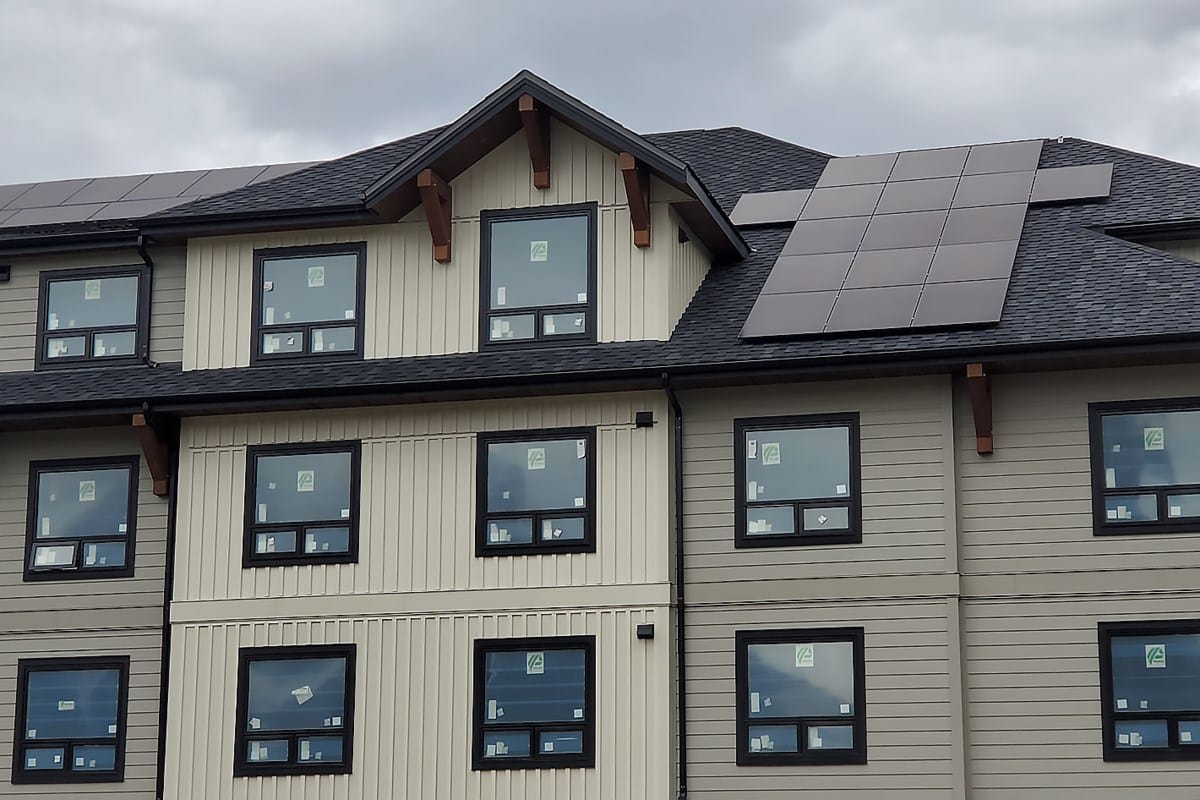[ad_1]
“This is an assessment. It’s a first step.”
CANMORE – A new study indicates potential options at the Town of Canmore’s disposal in attempting to make new buildings as energy-efficient as possible.
The study, Options for Achieving High Performance Resilient Buildings in Canmore, outlines potential recommendations such as having a climate risk and vulnerability assessment for development applications, updating the Town’s engineering design and construction guidelines to address climate risks – which is ongoing – as well as the land use bylaw and creating incentive-based programs to attain energy efficiencies.
It also recommended a look at Town policies to better align with the Climate Emergency Action Plan that was accepted for planning purposes by council earlier this year.
“This is an assessment. It’s a first step,” said Amy Fournier, the Town’s Energy and Climate Action coordinator. “It is trying to understand a little bit more about the implications of the codes and the options we have to advance the outcomes of high energy performance and resilience. … It’s an assessment of what could be effective, and nothing is happening immediately.”
Fournier highlighted the more energy-efficient buildings are constructed – particularly with a building’s lifespan between 50-80 years – the longer lasting impact they can have on climate and the environment.
She said efforts should be made to have construction of buildings be energy efficient when being built, due to the difficulties in retrofitting after the fact.
“Every building built to code minimum, and any building built that’s not net-zero, adds greenhouse gas emissions,” Fournier said.
“With new construction, it’s really this one-time opportunity to most cost-effectively build in energy efficiency at the time of construction. It’s much more expensive to try and retrofit later and usually you can’t get as good outcomes.”
In 2022, updated building codes were released by the federal government, which takes place roughly every five years. The Alberta Building Code came into effect last May, but went with the lowest of five tiers and municipalities are unable to require more than the code.
“From an energy perspective, there’s no real improvement compared to the previous codes,” Fournier said. “There’s also no specified timelines for progressing on those upper tiers, so we don’t know at this point where we may progress to Tier 2 or Tier 3.”
Completed by EcoAmmo Sustainable Consulting Inc., the 41-page report found provincial legislation can be a “major barrier to progress in green building.”
“The study confirmed that municipalities in Alberta are limited to incentive-based and educational tools for achieving higher levels of energy efficiency because local governments do not have the authority to regulate the same subject matter as the provincial building code,” according to Fournier’s report.
It noted in interviews with Bow Valley Builders and Developers Association (BOWDA), that it looked to have “clear, unambiguous and defined policy/program structures and a strong desire for inclusion in the development and implementation of any sustainability options.”
The report noted BOWDA also wanted to be involved early in any process to provide feedback, while having flexibility to attain sustainable options.
Brian Talbot, chair of BOWDA, said any changes considered to building code regulations should remain in the provincial domain.
“The Town of Canmore has a tendency to stray beyond its jurisdictional boundaries,” he said. “BOWDA strongly urges the Town to refrain from imposing building code regulations beyond its purview, leave it to the province, and avoid introducing additional, superfluous regulations.”
He highlighted the Alberta Safety Codes Act and Municipal Affairs Statutes Amendment Act (Bill 20) indicate the framework and authority for such regulations.
However, he pointed to an update to the land use bylaw potentially being beneficial, specifically when variances are required, and the organization will be looking for an update on the bylaw.
“It is BOWDA’s viewpoint that there are elements of the land use bylaw that are dated and fail to adequately address Canmore’s distinctive landscape, terrain, and geological characteristics,” he said. “Consequently, our members frequently find it necessary to request variances that then force them to exceed Alberta Building Code Section 9.36 – energy and efficiency requirements.
“This practice discourages innovative development and contributes to the escalation of housing costs. In the coming months, BOWDA will be requesting that the Town commence discussions with industry in regard to updating the land use bylaw. We can jointly work to a solution that addresses both parties’ concerns.”
The study was a capital project and meant to identify opportunities for new Canmore buildings to be built in alignment with the Town’s climate change mitigation efforts. It was approved in the 2022 capital budget at $25,000.
In 2019, Canmore council declared a state of climate emergency. Council aligned with federal government goals of achieving near net-zero by 2050. The new Climate Emergency Action Plan looks to reduce community GHGs by 30 per cent of 2015 levels by 2030 and 80 per cent by 2050 and Town-owned buildings for GHGs by 50 per cent by 2030 and 80 per cent by 2050.
“New buildings constructed today will last for half a century or more, representing a one-time opportunity to lock in energy performance in cost-effective ways that would be economically prohibitive in future retrofits,” stated Fournier’s report. “Upfront investments in energy efficiency also provide ongoing cost savings while improving health, comfort, and resilience to extreme weather, for the lifetime of the building.”
[ad_2]
Source link
